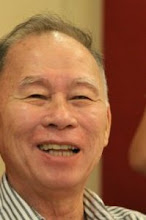San Lorenzo Ruiz Choir, a New
York-based music ministry, rendered an impressive performance last March 5 with
their angelic voices that echoed the Church of Our Lady of Queen of Martyrs in
Forest Hills.
Like numerous church choirs all over
Europe, this choir’s mission is rendered through apostolate music. “We share
our blessings through singing,” said Leo Paolo Leal, a tenor and music
director.
Blessed Pedro Calungsod was
canonized by Pope Benedict XVI last 21 October 2012. He is the second Filipino
saint. Like San Lorenzo Ruiz, who was martyred in Nagasaki, Japan on 27
September 1637, Saint Pedro Calungsod was martyred in the Marianas islands, the
present day Guam, on 2 April 1672.
Because he refused to
renounce his Christian faith, San Lorenzo Ruiz was tortured by being hung
upside down a pit. He died a painful death from blood loss and suffocation. His
body was cremated and his ashes thrown into the sea. Before he died, he said,
“I am a Catholic and wholeheartedly do accept death for the Lord. If I
have a thousand lives, all these I shall offer to Him.”
Blessed Pedro Calungsod, on
the other hand, was killed together with a Jesuit priest, Fr. Diego de San
Vitores, for having performed Christian baptisms in the village of Tomhom. A
former Christian convert, the village chief Matap’ang refused to have his
infant daughter baptized despite the mother’s approval. Matap’ang conspired
with the warrior Hirao to have Fr. Diego killed. Pedro could have escaped to
save his life but he stayed with Fr. Diego. Pedro deflected the first spears
thrown at them but a spear eventually hit his chest and he fell to the ground.
It is worth noting that the first two Filipino saints were both
lay persons. They were not priests or religious. San Lorenzo was married to
Rosario and had two sons and a daughter. He was working as a clerk for Binondo
Church when he went to Japan with several Dominican priests. He was only 36 or
37 when he was martyred. Blessed Pedro Calungsod, on the other hand, was a
cathechist who was chosen to accompany the Jesuit missionaries to convert the
native Chamorros in the Ladrones Islands, later named Marianas. He was a young
teenager, only 17 or 18 when he was martyred.
Another thing worth noting
is that the first two Filipino saints were both overseas Filipinos. One died in
Japan, another in Guam. Many often observe that Filipinos perform better and
behave better when overseas.
Filipinos in Indonesia and Thailand
are recognized and respected for their professional abilities. They are the
chief executive officers, chief
finance officers, chief marketing officers,
chief logistics officers of many large corporations in Indonesia and Thailand.
When you hear a band play beautiful music before an overflow crowd in a
five-star hotel, you can be certain that it is a Filipino band. In the United
Nations in New York, it is an accepted
fact that the UN headquarters cannot function well without the Filipino staff.
But Filipinos also bring
their Catholic faith overseas. Even in predominantly Muslim countries like
Indonesia, Malaysia and Brunei Darussalam, or in predominantly Buddhist countries like Thailand,
Laos and Cambodia, the Catholic faith is alive and the churches are full because
of the Filipinos. It is said that if one wishes to meet a Filipino while
traveling overseas, just go to a Catholic Church on Sunday. In fact in Kuala
Lumpur and Bandar Seri Begawan, there are Masses that are said in Filipino or
Tagalog.
The overseas Filipino workers are currently hailed as modern day heroes. But like
Lorenzo Ruiz and Pedro Calungsod, they can also become modern day
saints.
An overseas Filipino is a person of
Filipino origin who lives outside the Philippines. This term applies both to
people of Filipino ancestry who are citizens or residents of a different
country and to those Filipino citizens abroad on a more temporary status.
Most overseas
Filipinos migrate to other nations to find employment or support their families
in the Philippines. As a result of this migration, many countries have
substantial Filipino communities.
Often, these
Filipinos are referred to as Overseas Filipino Workers (OFWs). "Global
Filipino" is another term of more recent vintage.
Around 9.5 million to 12.5 million overseas
Filipinos are the estimated count worldwide or about 11% of the total
population of the Philippines as of 2010.
More than a million
Filipinos try their luck each year to work abroad through overseas employment
agencies and other programs, including government-sponsored initiatives. A
majority of them are women applying as domestic helpers and personal service
workers. Others emigrate and become permanent residents of other countries.
Overseas Filipinos often work as doctors, physical therapists, nurses,
accountants, IT professionals, engineers, architects, entertainers,
technicians, teachers, military servicemen, seafarers, students, caregivers,
domestic helpers, fast food workers and maids.
The exodus includes
an increasing number of skilled workers taking on unskilled work overseas,
resulting in what has been referred to as a brain drain, particularly in the
health and education sectors. Also, the exodus can result in underemployment,
for example, in cases where doctors undergo retraining to become nurses.
The country has produced six cardinals. The first Filipino
cardinal was Archbishop Rufino Cardinal Santos of the Archdiocese of Manila. He
was made cardinal in 1960 and died in 1973. Now, we have Archbishop Luís Antonio G. Tagle
who will be created a cardinal by Pope Benedict XVI in a papal consistory
scheduled on November 24, 2012. Upon this appointment, Tagle becomes the 7th Filipino
bishop to be named as a Cardinal with a mission to enrich the Roman Catholic
Church worldwide through the Filipinos’ faith.
(partly based on an article of Dr. Filemon A. Uriarte, Jr. is a
member of the International Council of Couples for Christ, former member of the Cabinet as Secretary
of the DOST and Executive Director of the ASEAN Foundation.)



